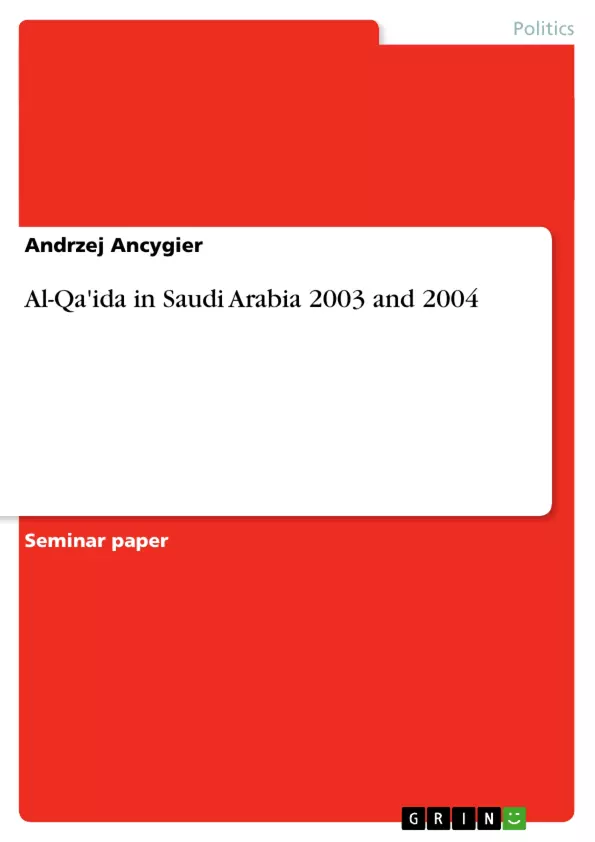Saudi Arabia is without a doubt the most important country in the Middle East. Its economic importance for the world and religious importance for Muslims could hardly be exaggerated. Therefore, when the first bombs exploded in Riyadh in May 2003, the shockwaves could be felt all around the world. Prophecies of Saudi rulers being overthrown and the Saudi Kingdom sinking into the chaos of civil war dominated the world press.
The picture of Saudi Arabia at the beginning of 2005 – almost two years after the attacks - looks much different. Saudi Arabia seems – for the time being – rather stable and the events of May 12 th and November 8 th 2003 appear to be a thing of a past. The monster of Islamic radicalism, which becomes alive once in a while in the Kingdom, seems to be defeated for now.
But the fight was neither easy nor won forever. In the meantime war in neighboring Iraq, which motivated most of those who wanted to fight against The Americans to leave the Kingdom, made it easier for Saudi rulers to fight against those few who stayed. Very soon, however, the situation is due to change. A history and analysis of the way that Saudi al -Qa'ida acted in 2003 and 2004 may give a glimpse of the things to come after the situation in Iraq changes and the Mujahideen start coming back home, like they did after the wars in Afghanistan in the 1980s and again in 2001.
Inhaltsverzeichnis (Table of Contents)
- Introduction
- I. Al-Qa'ida in the Arabian Peninsula – Abd al-Rahim al-Nashiri
- II. Saudi al-Qa'ida in 2003 and 2004
- 1. Building Structures of the Organization: Yousef Salih Fahd Al-Ayeiri
- 2. Saudi al-Qa'ida Starts to Operate: the Attacks of May 2003
- 3. The Crackdown
- 4. Khalid Ali bin Ali Hajj and attacks of November 2003
- 5. Abd-al-Aziz al-Moqrin
- 6. Saleh Al-Oufi and Saud bin Hamoud al-Otaibi: the decline of Saudi al-Qa'ida
- III. Ideology and Structure of Saudi al-Qa'ida
- 1. The World after September 11, 2001 and the New Strategy of al-Qa'ida
- 2. Iraq and Saudi Arabia as Major Fronts in the War Against “Infidels”
- 3. The Structure of Saudi al-Qa'ida
- 3.1. Saudi al-Qa'ida as an Ideology: Independence and Structure of the Cells
- 3.2. Saudi al-Qa'ida and other Terrorist Organizations in the Kingdom
- 3.3. Al-Haramain Brigades
- 3.4. The Connection Between Saudi al-Qa'ida and Usama Ibn Laden
- The rise and activities of Saudi al-Qa'ida in the context of global terrorism
- The organization's structure and its evolution during the 2003-2004 period
- The role of ideology and the impact of the war in Iraq on Saudi al-Qa'ida
- The relationship between Saudi al-Qa'ida and Usama Ibn Laden
- The broader implications of Saudi al-Qa'ida's activities for the region and the world
Zielsetzung und Themenschwerpunkte (Objectives and Key Themes)
This dissertation examines the activities of Al-Qa'ida in Saudi Arabia during the years 2003 and 2004. The study aims to analyze the organization's structure, ideology, and actions within the Kingdom, including the development of its strategy in the post-9/11 world. The research also explores the impact of the war in Iraq on Saudi al-Qa'ida and its relationship with Usama Ibn Laden.
Zusammenfassung der Kapitel (Chapter Summaries)
The dissertation begins by introducing the historical context of Saudi al-Qa'ida, tracing its origins to the figure of Abd al-Rahim al-Nashiri, a key figure in the organization's development. The first chapter explores al-Nashiri's involvement with Al-Qa'ida and his role in organizing attacks, including the bombings of American embassies in Kenya and Tanzania in 1998.
The subsequent chapters delve into the specific activities of Saudi al-Qa'ida during 2003 and 2004. The second chapter examines the organization's internal structure and the individuals responsible for planning and executing attacks. The chapter then analyzes the significant attacks in May 2003, marking the beginning of Saudi al-Qa'ida's active operations within the Kingdom. The third chapter details the Saudi government's response to the attacks, including the crackdown on terrorist activity.
The fourth chapter analyzes the leadership of Khalid Ali bin Ali Hajj and the November 2003 attacks. The fifth chapter focuses on the role of Abd-al-Aziz al-Moqrin, while the sixth chapter explores the leadership of Saleh Al-Oufi and Saud bin Hamoud al-Otaibi and the subsequent decline of Saudi al-Qa'ida's activities.
Schlüsselwörter (Keywords)
The core concepts explored in this dissertation include Saudi Arabia, al-Qa'ida, terrorism, transnationalism, local objectives, ideology, structure, attacks, post-9/11, Iraq, Usama Ibn Laden, and the Arabian Peninsula. The research investigates the dynamics between these elements, seeking to understand the motivations, strategies, and impact of Saudi al-Qa'ida.
- Citar trabajo
- Andrzej Ancygier (Autor), 2005, Al-Qa'ida in Saudi Arabia 2003 and 2004, Múnich, GRIN Verlag, https://www.grin.com/document/40004



